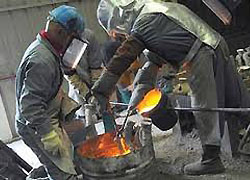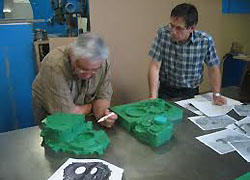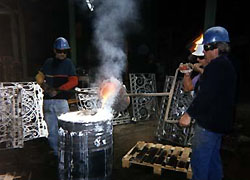The casting of aluminium and other light metals. Why the use of sand casting.

Technical parts in aluminium or other light metals can be produced by several casting processes: sand-casting (“green” sand or “chemical” sand), die-casting (gravity or pressure), investment (lost wax) casting, thixo-moulding (thixotropic moulding process), vacuum-casting and so on.
Our speciality is sand casting, both in “green sand” (sand + clay) and in “chemical” sand (sand + resins + hardener), since we want to be and remain as flexible as possible in order to provide the best possible service to our customers. It is also the best possible casting system for small and medium-sized batches, and for prototyping jobs.
The main advantages of aluminium sand casting are:
- Swiftness and reasonable cost of the start-up process
- Excellent precision at a reasonable price
- The product can be easily modified if necessary
- Ideal for small and medium-sized batches
But the cost-price of this process includes a high proportion of expensive labour cost/hours. This process also requires highly skilled and qualified personnel. Therefore, whenever the requested volumes increase, we subcontract the job to one of our colleagues, specialized in die-casting (“gravity” as well as “pressure”).
The modelling

This crucial phase will generally require a close cooperation with the customer’s engineers. Mostly, they will supply us with 3D drawings of the part to be cast. These drawings will then be handed out to one of our modellers (we work with three modellers, each of which has its own specialization), who will adapt the drawing in function of the chosen casting process. For instance, one has to take into account the “shrinking” of the molten aluminium during its cooling phase. The modeller will also include the casting channels into the mould (see details hereunder).
This adapted drawing will then be used for controlling a multiple-axis milling machine, which will carve the model out of a block of synthetic material. More commonly, we will endeavour to carve out several similar half-models on one slab. Two slabs will be produced, one for each half of the model (the “top” and the “bottom”). This reduces the time needed for the moulding process: it will be as if several moulds were produced at the same time.
Designing the casting tool (the canals, the cores)
The mechanical characteristics of the finished part will depend on the way the molten aluminium flows into the mould until it is entirely filled. The same is true for the amount of work that will be necessary for its finish. This “flowing” of the aluminium must be swift, but with as less turbulences as possible. Any impurity (oxides) will have to be filtered out with ceramic-sponge filters incorporated in the mould; the remainder will be concentrated somewhere in the mould but outside the part itself, so it can be removed subsequently, during the finishing process of the part.
This is “fluid dynamics”. Founders have been doing this for ages, without even knowing it.
One will have to take into account:
- Possible temperature differences in the part during the cooling phase
- Wall thickness differences that can cause temperature differences, and irregular cooling
- The need to envisage “reserves” of molten aluminium at some places so as to compensate the aluminium shrinking during the cooling phase
- Where and how to place the cores, and how to produce these core
- Where to place the ceramic filters for the oxides
- And so on...
The moulds

In theory, making a mould is quite simple: you just put the model in the sand, vibrate the whole for a while, open it and remove the model, and that’s it… But there are some hitches.
For instance, pure sand does not work: one has to add something to it. The two most widely used solutions are the “green” sand, and the so-called “chemical” sand. Green sand is sand mixed with clay and some water, plus some additives. It is the oldest solution used in foundries (in the ancient times –or in places where no clay was available-, excrements of domestic animals were often used instead of clay as a binding agent).
The second solution is to use resins and hardeners to bind the sand, which is then called “chemical sand”. This enables a more precise work than the “green” sand solution. This is used, for instance, for the casting of the motor blocks and cylinder heads of most top-end cars.
In both cases, used sand is recycled and re-used.
The alloys
There are numerous aluminium (or other light metals) alloys available on the market. The choice will be essentially function of the mechanical and physical characteristics required for the cast part. Will it have to withstand corrosion? Will it have to be welded? Is a very high mechanical strength a requisite? And so on.
Asides aluminium, aluminium alloys can include in various proportions: silica, magnesium, copper, nickel, zinc, titanium, cobalt, zirconium, strontium… Each foundry also has its own secret recipes and ingredients.
New alloys are invented from time to time. The latest “family” is the Aluminium-Lithium-Scandium assortment of alloys, widely used in military aircrafts because of its light weight combined with great mechanical strength. The problem is that Scandium 7 time more expensive is than gold…
Typical applications for sand casting
- Fast prototyping for automotive or aeronautical applications
- Small to medium-sized series for technical parts (machines for textile, agro-food or other industries)
- Furniture or art castings, designers projects, architectural components
- Any part subjected to high mechanical constraints (cylinder heads, motor blocks, torque converters, etc.
In short, any part where one or more of the following characteristics are required:
- Lightweight
- Precision
- Resistance to mechanical constraints and metal fatigue
- Weld-ability, good machine tooling-ability
- Good thermal conductivity
- And a reasonable cost-price.
A good example: look at this video showing how the Ferrari motor-blocks and cylinder-heads are produced in the Ferrari-factory (Modena, It.)
